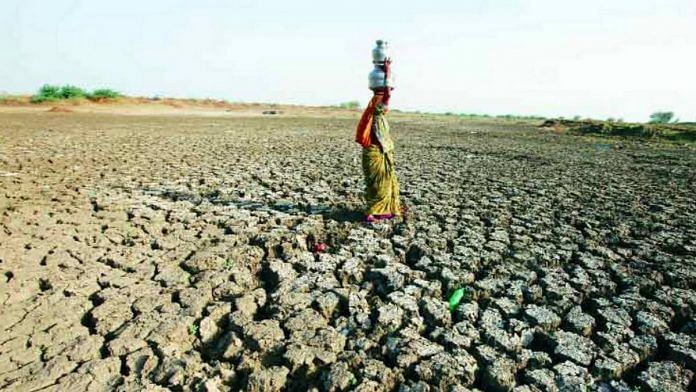New Delhi: Earlier this week, the US National Oceanic and Atmospheric Administration (NOAA) forecast that an El Niño was likely to brew in the tropical eastern Pacific Ocean, triggering speculations of a drought and a deficient monsoon in India, where several regions were battered by severe heat waves last year.
El Niño is a weather phenomenon that creates an abnormal warming of the Pacific Ocean, and has been known to negatively affect monsoons in India.
With the NOAA forecasting that there is a 50 per cent likelihood of an El Niño setting in later this year, which means it is more likely than a neutral condition prevailing, state governments in India are already on alert.
Maharashtra Deputy Chief Minister Devendra Fadnavis has reportedly warned his cabinet colleagues about possibility of a drought situation on account of the El Niño, and has advised them to come up with a comprehensive mitigation plan.
Scientists, however, say it is too early to say with certainty when the El Niño will set in since predictions at this time of year tend to be unreliable.
However, what is becoming increasingly clear is that La Niña, a weather pattern featuring unusually cold temperatures in the equatorial Pacific, is on the decline.
La Niña had persisted for three years and led to a wetter monsoon and cooler winter temperatures in India. This “triple dip” La Niña, which made its presence felt in 2020 and persisted through 2021 and 2022, is a rare event occurring in the backdrop of a changing climate.
“Normally, when forecasts are made before March, they aren’t very reliable because of what’s called the spring predictability barrier, which essentially means the system is very noisy,” said earth system scientist Raghu Murtugudde, visiting professor at IIT-Bombay and emeritus professor at the University of Maryland.
“However, this time we are coming off our third La Niña, during which the tropical Pacific has filled up with warm water, so any small trigger can give birth to an El Niño. The transition from a La Niña winter to an El Nino summer has caused some of the strongest monsoon deficits we’ve seen,” he said.
The forecast is likely to gain accuracy in summer, when the severity of the El Niño is also likely to become more clear, he added.
Also Read: Bengaluru firm has eyes in sky to fix problems on ground. Crops, insurance claims, floods
Effects of La Niña and El Niño
La Niña is when sea surface temperatures in the eastern equatorial Pacific are cooler than normal. Strong, east-moving trade winds and ocean currents bring cold water up to the surface — called upwelling — which causes this temperature anomaly. This condition leads to low air pressure over the western pacific, leading to higher rainfall, while causing drier conditions over the eastern pacific.
The opposite of this is an El Niño, when sea surface temperatures in the eastern Pacific are warmer than normal. This can cause rain in the eastern equatorial Pacific, and sometimes severe drought in the western equatorial Pacific.
Together, the El Niño and La Niña are two phases of the El Niño-Southern Oscillation (ENSO), which reflects natural changes in sea surface temperatures and air pressure. Both the El Niño and La Niña can impact global temperatures, with the former causing a warming effect, and the latter causing a cooling effect. When ENSO is neutral, neither El Niño nor La Niña are present.
While changes in the ENSO are naturally occurring phenomena, they can worsen the consequences of human-induced climate change, which have pushed global temperatures 1.1 degrees higher than pre industrial levels already.
“If an El Niño develops, which seems likely, then global mean temperatures will definitely rise further. Once mean global temperatures are up, there can also be local impacts in several places, but it’s far too early to say what those might be,” said R. Krishnan, director of the Indian Institute of Tropical Meteorology.
Last year, the World Meteorological Organisation, a UN agency, said with a 93 per cent likelihood that one year between 2022 and 2026 would be the hottest ever on record, and would temporarily breach the 1.5 degree threshold, the lower limit set by the 2015 Paris Agreement — an international pact that pledges to keep global warming in check.
According to Mahesh Palawat, vice president of meteorology and climate change at Skymet Weather, states can prepare by growing crops that require less water.
“Abnormal temperatures will affect the kharif crop and the quality and production, but it’s too soon to tell what the scale of the impact will be,“ he said.
There could be mitigating factors
Even if the El Niño does set in as predicted, there are other weather phenomena that can mitigate its effects, Krishnan said. Changes in the sea surface temperatures of the Indian Ocean — called the Indian Ocean Dipole (IOD) — can counteract the effects of ENSO.
“In 1997, there was a positive IOD during a very strong El Niño. Even though the expectation was severe drought, the monsoon turned out to be fairly normal, because of the effects of the positive IOD, which acted like a mini La Niña over India,” he said, adding, “There is a possibility of positive IOD developing this year too, but again, it’s too soon to tell. We will just have to wait and see.”
(Edited by Geethalakshmi Ramanathan)
Also Read: Mumbai among cities facing biggest threat as global sea levels rise, warns UN agency WMO



